I watched with great interest Tun Dr. Mahathir’s speech at Columbia University’s World Leaders Forum on 25 September 2019. At 94 years old, he is the oldest Prime Minister in the world–being older than Queen Elizabeth by over 8 months.
Amazingly, Tun Mahathir is still very, very sharp.
He was able to answer both easy and hard questions with ease, calmness and clarity–thanks to his vast experience.
About two weeks ago during my roadtrip in Cambodia, Tun Mahathir (Tun M) was in Phnom Penh. And since last week, he was in New York City for United Nations General Assembly (UNGA). Do check out Tun M’s latest speech at 74th session of UNGA (Full text and video).
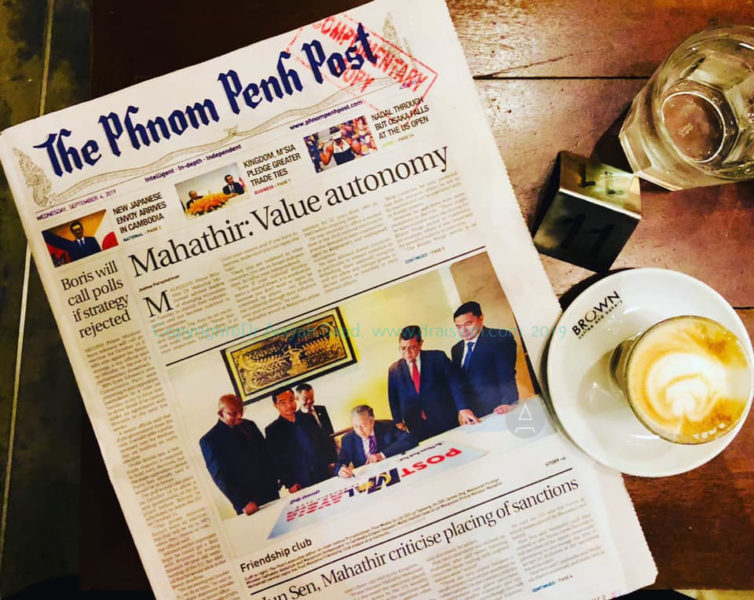
Tun Mahathir in Phnom Penh, Cambodia. Gets huge coverage than the British Prime Minister.
Photo © Dr Aisyah Saad, 2019
What can we learn from Tun Mahathir’s session at Columbia University?
I have deep respect for Tun Mahathir for being a visionary and courageous in implementing his ideas in developing Malaysia to where it is now. A modern nation that stands proud with other developed nations today. An example to many countries.
During my oversea travels, when I mentioned that I’m from Malaysia, the reply was always Mahathir. Malaysia=Mahathir
That’s the M for in latest documentary about the 2018 General Election 😉
Regardless of the popularity/performance of Pakatan Harapan or Tun Mahathir (Tun M) on social media at the moment, we all can learn something on the art of presenting from this interesting forum session.
As you are aware, a speaker not only has to deal with his content, but also should be able to handle the Q&A well. In this post, I would like to share 3 presentation takeaways, drawn from Tun M’s session, on:
- Diffusing tension
- The audience
- Expressing ideas in plain English
Just in case you’re preparing to speak or moderate an international session 😉 Read on.
1. Assert own boundary with a smile
Tun M’s visit to the Ivy League university preceded not without strong protests from student members of SSI Columbia. During the Q&A session, a Jewish female student posed a question asking Tun M to clarify his position on the Holocaust. With understated poise, he asserted his rights to free speech–as being enjoyed by you, me and many other civilised people.
Then, Tun M further explained what is not free speech with examples. One example cited was the case of an English journalist imprisoned for disputing the numbers murdered in Holocaust. More here.
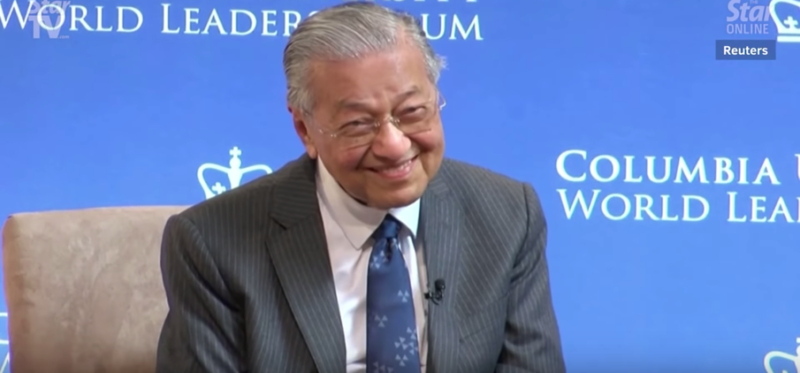
This part of the Q&A could easily escalate to heated arguments. One that goes back and forth with no ending. How to handle such question with grace, composure and wit?
Experience speaks louder than words
This is where Tun M’s experience speaks the loudest. When the female student interjected his reply, an inexperienced speaker would likely ignore the first sign and continue explaining. Or… go quiet and look at the moderator for help – to control the room.
Instead, Tun M seized the moment. Watch this video clip.
He seemed to sense the underlying tension. The foreboding ‘danger’ of staying too long on the subject. Tun M simply said, “Ok. Thank you. I think I’ve said enough” with a smile. Elegantly said, love it!😍
Why elegantly said?
Two points:
- Tun M’s reply was timely, assertive yet polite.
- Tun M said “I’ve said enough.” instead of “You’ve said enough.”
Subtle but has significant effects on the questioner. Notice that the former asserts own boundary, and diffuses, not sparks, the tension. If you can’t do humour, a smile is suffice. It diffuses the tension even further.
Takeaway: For leaders and speakers, how uncomfortable a question gets… do address it and don’t ignore. Tun M is known as a world leader who speaks his mind. He speaks his mind based on facts.
If faced with such situation, what can I do? State the reality of the situation, address hard questions by explaining your position based on facts. Know when to stop. And of course, use Tun M’s brilliant reply “Ok, thank you. I’ve said enough”. End it by flashing your sweetest smile 😁
2. Who is your audience?
The distinctive presentation style of Tun M was somehow in stark contrast to the moderator.
I’m not a historian, or in international relation/business or political sciences.
I could clearly understand the haze issue, but I found the rest of the moderating session quite hazy. I could not follow the moderator’s thought processes–the context and significance of the issues at hand were not explained to a layperson.
The moderator’s session felt ‘jumpy’ and rushed with hardly any sense of direction.
Imagine asking Tun M this question: “Because I’m a pharmacist, therefore I would like to find out how haze can affect our health. As a medical doctor, can you please enlighten us on the mechanism of action of haze particles on the respiratory system?”

How was it related to what Tun Mahathir just talked about? 🤷♀️
Another stark contrast… The questions during the moderating session seemed unrelated to Tun M’s speech, whereas the questions fielded during the Q&A session were closer to home. Watch minutes 38 and 46. Where things get interesting.
A lesson in self-interests vs. the audience’s.
The highly anticipated event was live-streamed and watched by people around the world. Some may be well-versed in the topics. Many more (e.g. millennials) perhaps know much less about Tun M and his policies. Multi- and unilateralism, ASEAN role, non-aligned movement, OIC. More about Tun M here.
To Malaysian social media users, OIC would like mean “Oh, I see.”

Academics like to deep-dive instead of snorkelling.
Many academics and professionals tend to fall into this trap (including yours truly). “Syok-sendiri” as Malaysians put it 😉 When we want to talk about something big and great, we spice it up with abbreviations. We somehow forget about our audience.
Alas, some academics may look intelligent in unintelligible manner.
Takeaway: However excited (or nervous) you are about a session, your work/research… just calm down. Find out who your audience is. Craft a backstory, or simple introduction that suits your audience – before presenting your work. For moderators – preamble your ‘deep-dive’ questions.
If the audience are educated but outside your intellectual circle, find out what their interests are. Ask, why they come to listen to your talk? Step outside your ‘little academic sphere’.
Drop the jargons. Connect with the audience.
Your audience will thank you for that.
3. Express your ideas in plain English
Tun M started off the forum by explaining the reasons why he, as the former head of the ruling party, decided to go against the party? Have a quick read over a partial transcription of his speech below:
I’m not loyal to the party. I’m loyal only to my country.
Tun Dr. Mahathir Mohamad’s opening speech at Columbia University’s World Leaders Forum on 25 Sept 2019.
If my own party does something that is wrong, I felt it is my duty to do something about it.
More so when people came and asked me to do something about the government which succeeded me.
Doing something may take the form of advising, or demonstrations…
But I decided to join the opposition in order to bring down the party I had left for more than 20 years.
Fortunately for us, we were able to win in the last election.
This is not usual.
Because the party which ruled the country was the same party which won the independence for the country, and has been the government for more than 60 years. 61 years to be exact.
And nobody really thought this party would lose in any election. Because it’s a powerful party. It’s a crooked party. It’s going to use within its means to stay in power.
But fortunately for us, the people decided it was time that the previous party should step down. And give way to a new party.
So we won the election with a good majority.
We won it with a peaceful manner.
Check if you can:
- detect any big words or technical terms?
- follow Tun M’s thought process?
- answer, why did he return? What was the big challenge?
- What happened during the last election? What’s the turning point?

Photo credit: Berita RTM
How did Tun Mahathir present his ideas well?
Notice how Tun M outlined to the audience the key events took place in the last Malaysia’s general election. And his reasons for the comeback. His big why is a hook.
A major event that brought about huge changes to Malaysians, after 6 decades. Another hook. Lots of things happened. The audience would want to know what have happened since the big change.
Yet he made it seemed so flawlessly simple. I think firstly, because he used plain English, and spoke in active voice rather than passive. Most words he chose were also short thus ‘digestible’, easy to follow with no double-meaning.
And he didn’t read from any text, nor used any slides–similar to Prof. Muhammad Yunus’ captivating lecture.
Uncomplicated and to the point with a simple story arc. It’s like reading from a Reader’s Digest.
The intention is to make things clear.
Takeaway: Master expressing your ideas in simple, plain English. Study his speech before your next presentation. A language of a great leader, I’d venture to say.
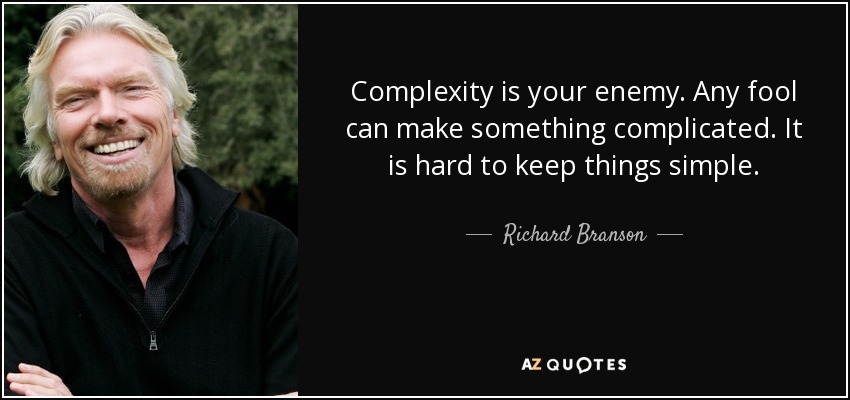
Final thoughts
In my recent FB post, I mentioned that I like the way Feynman thinks. As a former educator, I was aware how easy I could get sucked in academic jargon jungles. And appearing intelligent😆
Feynman thinking had helped me in making my lectures simpler. The first step in Feynman’s method: can you teach a topic to a child?

A quick scenario: When people ask, what research are you doing?… Will you able to summarise your research in 1 sentence? In plain English and no bombastic words. Just like our Prime Minister, Tun Dr. Mahathir.
So start expressing your big ideas to someone with limited vocabulary. Keep practising. You’ll be on the path to greatness.
In sum, three presentation takeaways from Tun Dr. Mahathir’s session at Columbia University NYC for my readers – should you wish to deliver an effective presentation or moderate an engaging session.
For starter tips on effective use of visuals and slides, check out my top blog post.
You can read more about my presentation approach in my book Elevate–a collection of stories and lessons throughout my years in academia. And I leave you with my mantra in presentations: keep it short, simple and sweet. KISSS.
Works like a charm =)
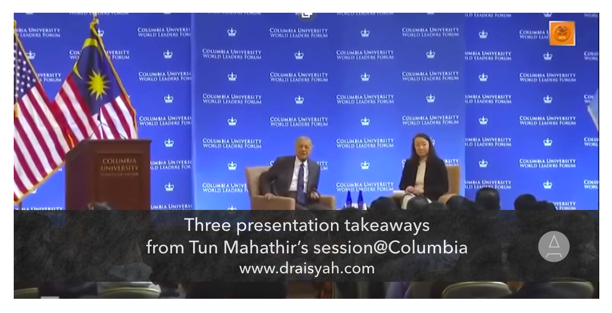
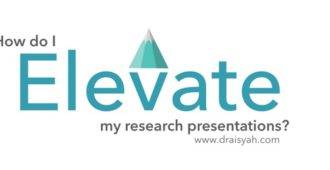
Comments are closed.